| Made in | USA |
| Length | 25 – 100 feet (extensions available) |
| Gravel tube | 10-inch long, 2-inch diameter (longer tubes available) |
- Easy To Use: Hassle free! No buckets, no siphons, no mess, no tank tear downs ever again! Every aquarium owner has felt the utter frustration of lugging a heavy, water filled bucket to your aquarium and spilling it on the floor. But those days are gone! Let the Python put the effort in and do all of that heavy lifting for you!
- Master Routine Maintenance: Regular water changes and a maintenance routine help to keep our favourite aquatic pets happy and healthy, and should be done regularly! But all aquarium owners know that maintenance and water changes can be hard to keep up with, especially with a busy schedule. The Python system eliminates the dread and frustrations associated with water changes and allows you to complete the task in mere minutes, not hours! Spend more time looking at your tank, not cleaning it!
- Everything You Need: The complete ready-to-use system comes equipped with a hose, gravel tube, switch, hose connectors, faucet pump, and brass faucet adapter so you can get started on maintenance right away. The system quickly and easily attaches to most faucet styles and can be fully installed and ready to go in less than 5 minutes!
The Python water change system was created by Lance Reyniers, a lifelong aquarist.
Just like me, Lance hated hauling heavy buckets of water back and forth during weekly tank water changes.
Unlike me, he decided to do something about it…
So, Lance created the Python No Spill Routine Aquarium Maintenance System – a handy device that allows you to empty and refill your aquarium with ease.
Today, I am going to test and review this water changer in order to answer one simple question:
Is the Python water changer worth your hard-earned money?
So, join me as I share my experience with the Python water changer.
Spoiler: The Python aquarium water changer system took the number one position in our best aquarium water changer guide.
Contents
What’s in the box?
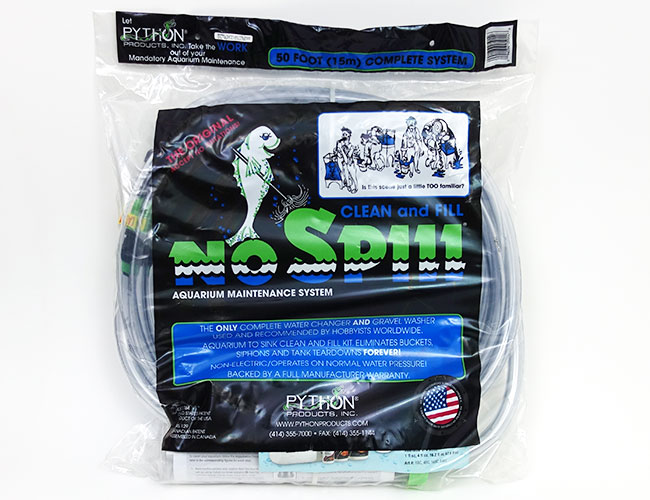
Sure, the packaging may not make the Python water changer stand out on the shelf of your local fish store. But that doesn’t matter – it’s what’s on the inside that counts.
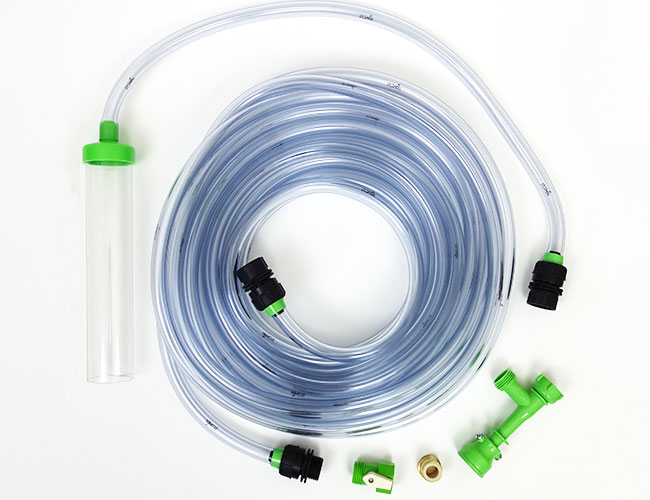
Here’s what you will find inside your new Python water changer kit…
- Hose
- Gravel tube
- Hose connectors
- On/off switch
- Faucet pump
- Brass faucet adapter
Everything you need except a kitchen sink.
There are four different water changer kits available, and the only difference between them is the length:
Measure the distance between your faucet and fish tank and choose the appropriate length. The measurements include the gravel tube. So, if you find that your required length is on the borderline, I recommend that you choose the next size up.
Maintaining the Aquarium with the Python Water Changer
The Python water change system takes the headache out of regular aquarium maintenance. You’ll find cleaning a cinch when you use this python aquarium cleaner. Simply attach the gravel vacuum tube and flip on the tap.
The Python utilizes a siphoning effect to remove dirty tank water and debris from the substrate while fresh water flows in. Control the suction as needed with the on/off switch.
For deep cleaning, I would advise you to aim the Python water changer at areas with more waste buildup. With this handy Python water change system, you’ll get sparkling clean water without the scrubbing.
Choosing the Right Python Size for Your Setup
The Python water changer comes in sizes ranging from 25-100 feet long. Select the right sized Python for your situation based on the distance between your faucet and tank. When setting up, securely connect the pieces gravel tube, hose, on/off valve, and tap pump.
From my experience, it’s best to verify a tight, leak-proof fit before your first water change with the Python aquarium cleaner. With a properly sized Python water change system, you’ll avoid frustrations and have a smooth experience.
Design
Imagine a gravel vacuum that connects to your faucet. That’s essentially what the Python water changer is.
Let’s take you through it, piece by piece, starting with the end that goes inside your aquarium, the extended length gravel tube…
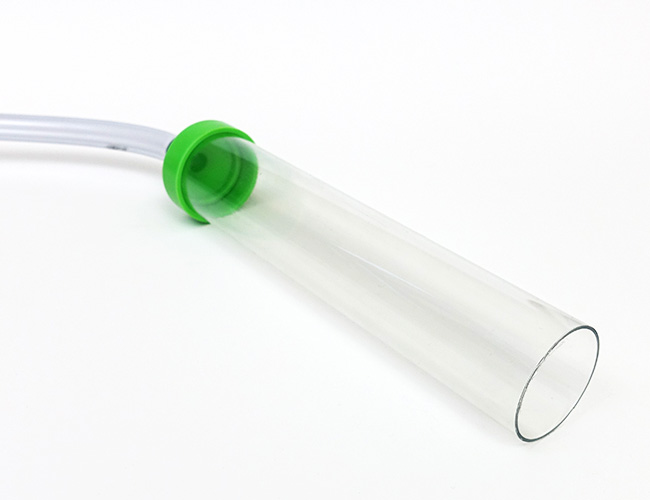
You can use this tube to vacuum the gravel substrate in your aquarium while draining your tank at the same time!
The gravel tub hose connects into the on-off switch.
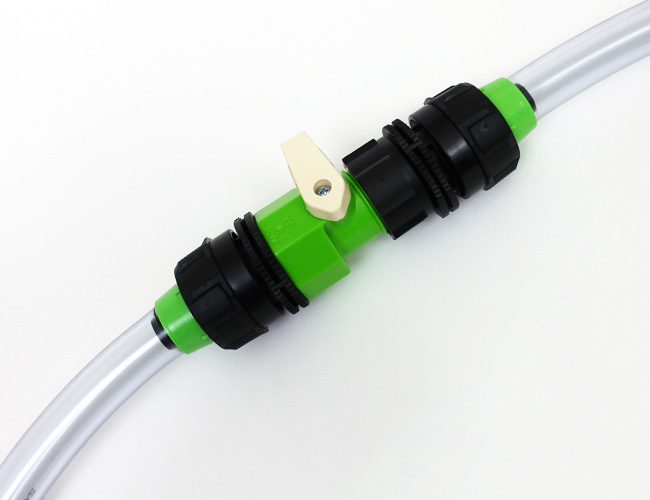
If you have used a gravel vacuum before, you know to kink and unkink the hose to control the flow of water.
Not necessary on the Python water changer! Simply toggle the on-off lever to stop and start water flowing from your tank.
Once past the on-off switch, the water from your tank is going to take a long journey through the hosing…

… Before it finally gets to the faucet pump.
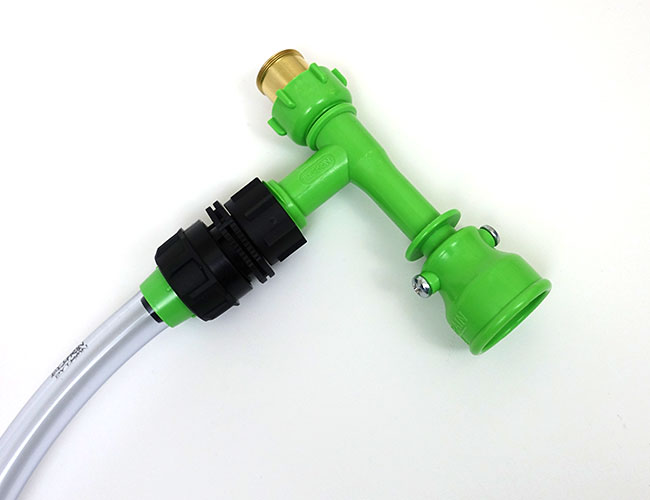
This is the piece that connects to your faucet. As you drain your aquarium, faucet water flows out the bottom and into your sink.
Combine all these parts together, and you have the Python water change system.
Turn the faucet on and fresh water will begin the journey back through all these pieces before finally emptying into your tank.
It might be simple, but I was very impressed with the build quality. While other weekly water changers use a similar design, their plastic components felt flimsy compared to the Python water changer.
Usability
Now we get to the part where we test how the Python water changer holds up to real-world use.
Before I continue, I want to stress that cold water changers come with a slight learning curve. If you have never operated an aquarium water changer before, read over our how to use an aquarium water changer guide. It will help you avoid common mistakes that many beginners make.
So, the first thing we did was to hook our Python water changer up to our faucet.
The brass adapter included in the kit fits standard-sized threaded faucets. We simply popped out our aerator and screwed the aquarium water pump directly into our faucet. All in all, it took less than 30 seconds to set up.
Now if you have an unusual faucet, such as a sprayer faucet, then you might need a bit of extra equipment to connect to your water changer.
Fortunately, Python has a wide range of adapters available. Unfortunately, these are sold separately.

If you already purchased your Python water changer, and need one of these adapters in a hurry, you should be able to find the equivalent in the plumbing section of your local hardware store. If you take the aerator with you, the staff will be able to match it up with the fitting you need.
With the water changer hooked up, it was time to take it for a whirl.
As you are no doubt aware, the first step in performing a water change is draining your water.
So, I adjusted the basic water pump to the ‘drain’ position and turned the faucet on. This creates what is known as the Venturi effect. As the flow of water from the faucet through the pump and down your sink, it creates a vacuum effect that sucks water out of your tank.
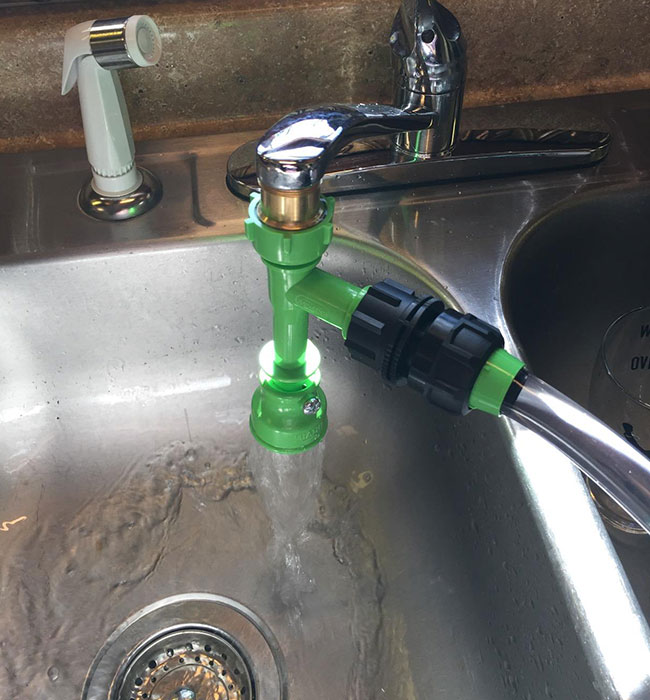
Now all that was left to do was to use the gravel tube to vacuum the gravel substrate as I normally would. The on/off switch made controlling the water flow a simple task, with water being sucked out of my tank and down the drain of my kitchen sink.
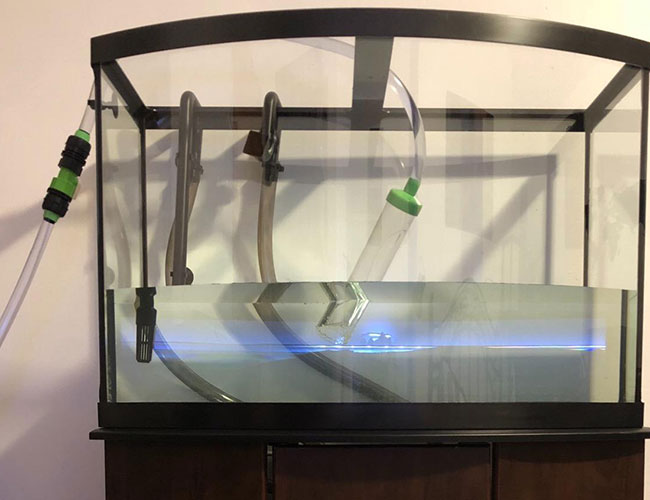
If you don’t want to use the gravel tube, it can be removed, allowing you to position the hose to drain water from your tank instead.
Once you remove an appropriate amount of water, it’s time to fill your tank up again.
So, I turn the switch to the off position and walk over to my kitchen sink. By adjusting the pump, water will no longer flow through it, but up through the hose and into my tank.
Now, all that’s left to do is turn the faucet on, return to my tank, turn the switch on and wait as my tank refills with fresh water.
I was pleasantly surprised that the Python water changer reduced my water change time by 20 minutes. Yep, 20 whole minutes less spent doing a chore – who could say no to that?
The Python water changer is a simple product that does exactly what it claims.
Spare parts and accessories
The Python water changer has four optional accessories available, sold separately, for you to enhance your water changing experience. Whether you need these entirely depends on your setup…
For some of you, these will be essential!
1. Gravel tube
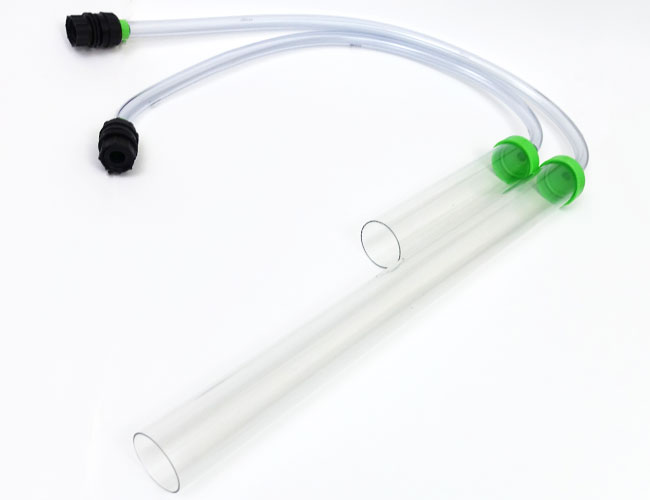
The Python water changer comes with a 10-inch long gravel tube as standard. Those of you with deeper tanks might find the tube is unable to reach the bottom of your tank without getting your hands wet.
If you want to keep your hands dry, you have two options:
- Grab yourself a good pair of aquarium gloves
- Buy a gravel tube that will reach the bottom of your tank
Fortunately, Python sells gravel tubes in a range of different lengths:
All these gravel tubes effortlessly attach to your Python water changer, allowing you to reach the bottom of even the deepest aquariums.
2. Extension hose
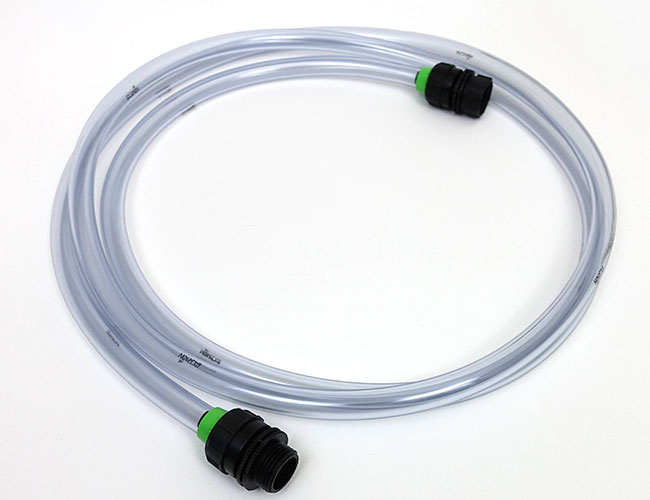
Bought a Python water changer only to discover it just won’t reach your tank?
Or, maybe you moved to a new house and discovered that your water changer is just too short to reach your tank’s new location.
In any case, you don’t need to go out and buy a longer water changer – Python sells extension hoses to give your current water changer a bit more reach.
This extension hose is available in two lengths:
These extensions securely clip into your Python water changer in seconds. I was able to successfully attach two extensions to my water changer and use it as usual without leaks.
3. Hands-free hook
- Designed for use with Python No Spill Clean and Fill Systems
- Simplifies routine water changes and provides peace of mind
- Ensures a hands-free, spill-free experience every single time!
While filling up your larger tank with the gravel tube attached works well enough, care must be taken to correctly position it, or you risk it falling and spraying water everywhere.
Screw the hands-free hook onto your water changer when you are ready to fill your entire tank, hang it from your tank, and you won’t have to worry about water going everywhere, only inside your tank.
If you find yourself holding your water changer in one hand, then the hands-free hook will do just what it claims – freeing your hands to do more important tasks while your tank refills!
4. Heavy-duty Velcro straps
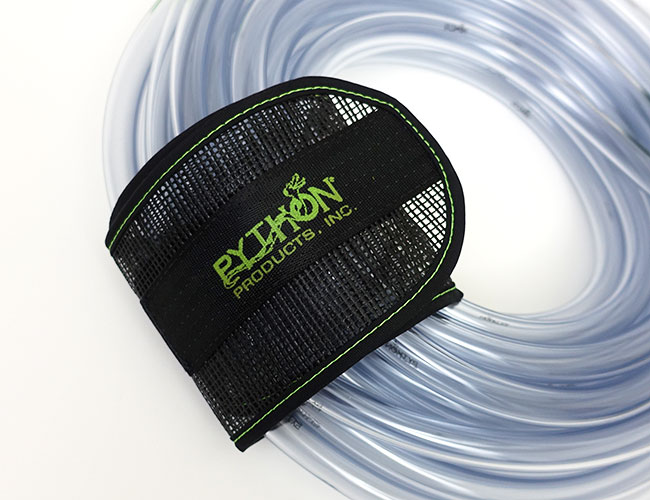
- Aquatic
- Maintenance & Cleaning Supplies
- Siphons (Water Changing)
With Python water changers stretching up to 100 feet in length, coiling the hose up once you are finished with it can be a messy job.
To keep your water changer neat and tidy in between uses, Python sells heavy-duty straps to hold the hose in one tight coil.
Look, these straps are super-handy, well-made and do a great job at keeping your water changer neat when not in use. But of all the available accessories, this is the one that I object to buying the most – in my opinion, the strap is overpriced and should have been included in the standard kit.
What we liked…
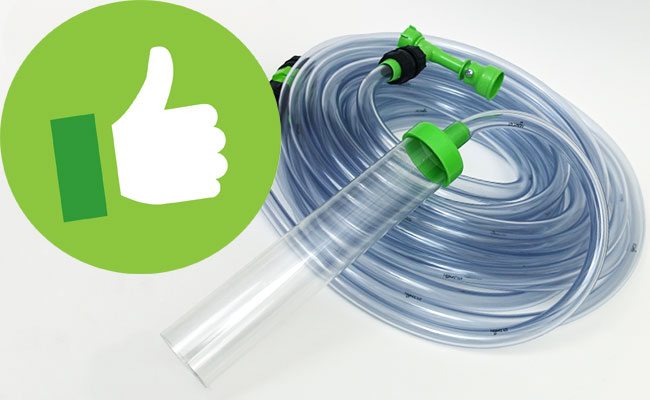
1. The Python water changer makes emptying and refilling your tank easy
Believe what everyone says:
The Python water changer really is that good.
The entire process felt… liberating. While a few trips back and forth were required, I didn’t need to make the trip hauling a heavy bucket through my house, which was a lovely change.
In fact, compared to using a bucket to empty and refill my tank, the entire process was effortless.
2. Good, solid construction
Maybe it’s because this is the only water changer on the market that’s made right here on American soil.
Or, maybe this is the reason the Python costs a little more than other water changers – quality comes at a price.
Whatever the reason, Python makes the best-constructed and most-durable water changer on the market.
While the design of other water changers may look similar, at a lower price, it came at the sacrifice of quality – something that Python didn’t trade off.
It’s no surprise that some owners report that their Python water changer has lasted over 20 years before needing to be replaced.
3. Replacement parts and accessories
Speaking of replacement parts, every single piece of your Python water changer can be purchased separately.
Cut your hose? Buy a new length!
Crack a connector? Grab a new one!
It sure beats tossing out the entire water changer just because one part failed.
But what we really liked was the ability to swap out to a larger gravel tube to get to the bottom of deep tanks.
What we didn’t like…
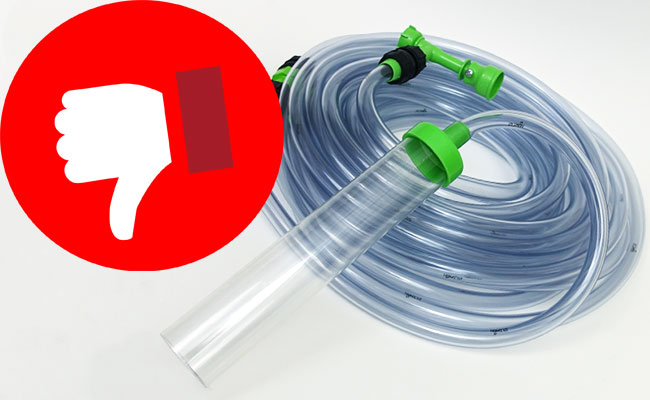
During testing, we actually struggled to come up with any major complaints about the Python water changer. It’s a simple quality product that does what it promises and better than any other product on the market.
Perhaps the only thing we could grumble about is what isn’t included in the box.
Some of you will take your new water changer home only to discover that you need to head back out to pick up a different brass fitting to make it work with your faucet.
Python sells all these fittings separately. It would have been nice if they were included so that everyone, regardless of faucet style, could use the water changer straight out of the box.
Also, it would have been nice to see the heavy-duty Velcro straps included in the box, instead of sold separately. These straps make keeping your water changer neatly coiled a simple task.
Considering no other water changer on the market includes any of these in the box, this is a pretty minor complaint.
Getting the Most Out of Your Python Water Changer
The key to successfully using your Python water changer is understanding how to optimize it for your particular aquarium setup. When first learning how to use Python water changer, take the time to experiment with different gravel tube sizes and suction flow settings.
Finding the right configuration for your tank dimensions and substrate will allow you to maximize efficiency. Also, practice using the on/off switch to control the water flow for both draining and refilling. With experience, you’ll become adept at regulating the force of the siphon during a water change.
Don’t be afraid to detach the gravel tubing and use the Python water changer hose directly for customized spot cleaning.
Finally, rinse and neatly store your Python after each use to prevent kinks and knots from forming in the hose. Following these tips on how to properly use Python water changer will help you get the most out of this handy aquarium maintenance tool. With the right techniques, you’ll be able to breeze through weekly water changes.
Additionally, be sure to have a designated workspace ready when it’s time for a water change with your Python system. Clear a spot close to the tank with all your supplies like gravel cleaner, algae scrubber, nets, and water conditioner within arm’s reach. Staying organized during maintenance makes the process faster and prevents messy accidents or spills while using your Python water changer.
Python vs Aqueon: Which water changer is better?

It’s a question that I am constantly asked…
Out of the two most popular water changers on the market, which one should you buy?
If you have already read my Review of the Aqueon Water Changer, you will be fully aware that it failed to impress.
Let’s compare the two side by side, starting with the faucet adapter…
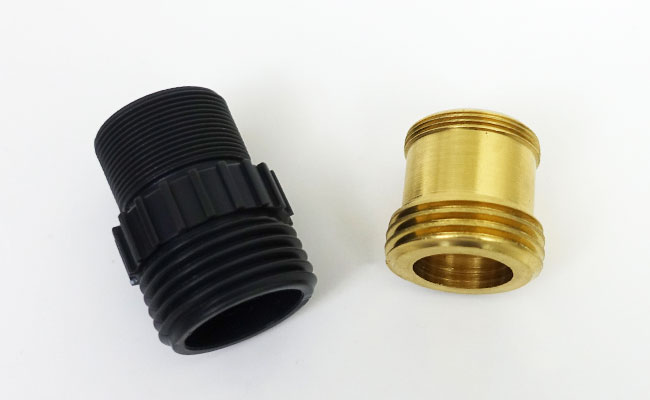
It might seem like a simple piece, but this small adapter is responsible for keeping your water changer securely connected to your faucet.
During our testing, Aqueon’s plastic adapter failed twice, resulting in leaks.
Python’s adapter, on the other hand, is made from brass and incredibly durable.
Winner: Python
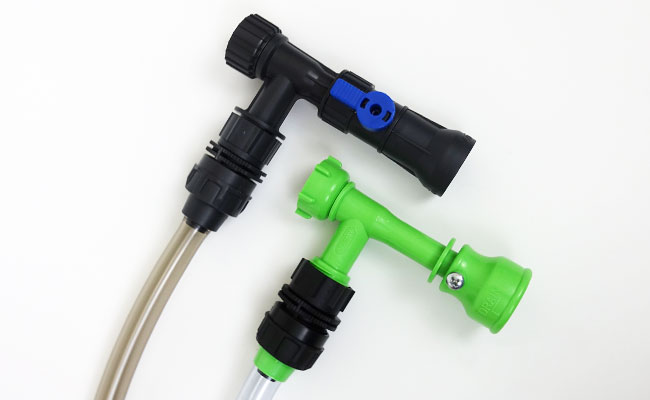
Aqueon’s flow valve was made of thin plastic that could flex when squeezed.
Python’s solid design was easier to operate.
Winner: Python
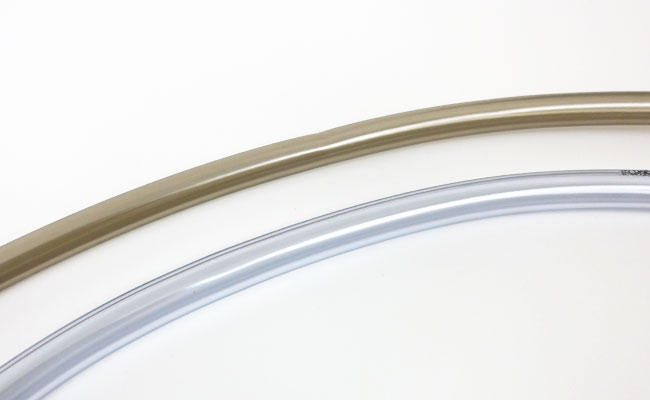
Aqueon’s hosing kinked easily and gave off a strong chemical smell, which stunk up our office.
Python’s tubing held its shape, and while it had a faint odor, the smell quickly faded.
Winner: Python

Next up, you have the gravel tubes.
We actually preferred Aqueon’s handle to Python’s. Aqueon’s tube is also made of a more rigid plastic.
Python made up for this by offering tubing in a wide range of sizes, up to 72-inches long, suitable for deeper tanks.
Winner: Tie
The only thing that Aqueon beat Python on is price. Unfortunately, it came at the cost of quality.
Do you need a Python water changer?
So, the number one question that everyone has about the Python water changer:
Does it really make your water changes easier?
Well, if you have a larger-sized tank that requires you to make multiple bucket trips for every water change, then I will say this:
What are you waiting for? Buy this now!
Fewer spills, less effort and less time spent performing water changes? Yes, please!
If you value your time, then the Python water changer is worth the cost twice over. I’m never going back.
However, if you have a small tank and you swap out just a few gallons of water each time you perform a water change, the Python water changer is overkill. Grab yourself a good gravel vacuum instead.
While it may cost slightly more than the competition, the python water changer more than makes up for this with its durability – it’s the sturdiest water changer on the market.
Looking for a good water changer for your aquarium? It doesn’t get any better than this.
I rate the Python water changer 4.8 / 5 starfish.
Highly recommended.
What do you think of the Python water changer system? Let me know in the comments below!

Ian Sterling, founder of Fishlab.com, began his aquarium journey over 30 years ago, driven by a deep fascination for fish and their diverse personalities. His website, Fishlab.com, is dedicated to making fishkeeping accessible and enjoyable, offering beginner-friendly guidance, expert insights, and a community for aquarists to connect and share experiences.


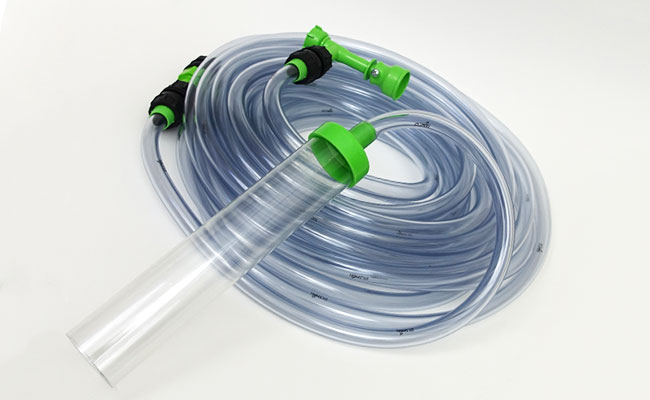




Comments (12)
Each 5 gallon bucket of water weighs 41 lbs. when I calculated the total weight of a 25 gallon water change (5 buckets x 41 lbs = 205 lbs) carried twice (to clean and refill) meant 410 lbs each week! No wonder it hurt. The Python Aquarium Maintenance System is a back saver.
Over the years I’ve customized my Python. I added garden hose quick connects to easily snap it on the kitchen faucet. I’ve made it longer and changed the gravel tube for a deeper aquarium.
The latest change I made to was to accommodate the recent California droughts. Water here is resource not to be wasted. Using water pressure to pump water out of the tank wasn’t OK anymore (expensive too????)
Buying a little electric one tenth horsepower water transfer pump at Harbor Freight solved this dilemma. Additional quick connects, a filter thing to catch the debris from the gravel before it went through the pump and patience figuring out the details to safely use the pump did the trick! The Python Venturi part is used to prime the new set up and drain the hose when done.
????
Hi Leslie,
Thanks for sharing again. Out of curiosity, how long have you had your Python for? I think it’s the quality that sets it apart. I have not spoken to anyone who has had their Python system fail to the point it had to be trashed. In the days of cheep junk products, it’s truly refreshing to see.
On your modification part, you are a genius. I currently use Pythons quick connect fitting, but a garden hose fitting would have been so much cheaper.
You’ve also made me realize how much I take running water for granted. I love the pump idea, as using tap water for suction is very wasteful, especially when cleaning 4 tanks at a time. I’ll definitely be looking into this. Thanks again!
I ordered my faithful 50 foot Python from an aquarium supply catalog via snail mail in 1993! It is 70 foot long now.
The key to getting the pump thing to work for me was knowing the pump likes to “push” the water rather than “suction” it, in other words putting the pump at the end of the Python where the Python Venturi is doesn’t work. Instead I installed the pump (using more garden hose quick connects & additional male and female Python hose parts I ordered on Amazon) about 15 feet from the gravel tube end so it happily pushes the water down the long section of the hose to drain in the kitchen sink. When it’s time to refill the tank I detach the pump, rejoin the Python hose then hook the far end in the sink up to the kitchen faucet (after the tap is running at the right temperature) All Done!
The 15’ section between the pump and the aquarium is the only section that needs to be primed for it to work!
1993? I think that’s just about the longest I have heard that anyone has owned one. I know it’s had some changes in that time, but even so, 25 years is darn impressive. I honestly wish I knew about them back then, it could have saved my back from a lot of pain.
Thanks for the extra info on how I can implement a pump. It sounds like you have water changes down to an art!
Help! Why is it impossible to find extensions (pref clear) for the siphon end of the Python Hook which has a depth of only a few inches? It appears as though it was made to accept another part (siphon end is slightly indented) but I can’t find a single image showing such, nor any Python part that would fit.
I have a 100 gal, 24” tall tank and a125 gal, 6’ long tank. I do frequent 50-80%water changes plus total tear-downs as necessary. I assumed the hook could be lengthened to enable deep hands-free water changes with ease. Instead it drapes just a few inches over the tanks.
After considerable research the only thing I’ve been able to find is an AquaClear Extension Tube for Power Filters (w/integrated strainer) which slips over the Python Hook by about an inch, adding 5-1/2” to the hook, allowing max 25-30% water changes. It would take about 3 of them plus the hook to reach full depth.
I could just use the hand held Python Gravel Cleaner for water changes, but I don’t thinks it’s as stable/carefree (draping over the tank) during water changes.
How does such a short-depth hook (without extensions) work for others? I’m baffled! What am I missing? Any thoughts?
Hi Angie,
You actually raise a very interesting point, I have not heard of anyone using the hook like that. The purpose of the hook is so you don’t have to worry about the hose and gravel vacuum falling out of your tank when you refill.
When performing a water change, it’s generally expected that you perform a gravel vacuum too, to clear up any uneaten food, poop, plant matter etc, that falls in between the gravel and rots. If you are just using the hook for water changes, you are not cleaning the bottom of your tank. That’s why the Python Water Changer uses a “gravel vacuum” to empty” the hook is just an optional extra to make refilling easier.
I think this may be the reason why you are having so much difficulty, you want to use the hook for a purpose different to that it is intended. Don’t get me wrong, I think it’s a really cool idea as on occasion I have wanted to drain my tank without gravel vacuuming, but the hook isn’t the right tool for it.
Hi guys,
I have recently purchased the Python kit for the first time & like yourself i feel that it is a god send, i say this after many years of keeping aquariums on and off.
I have recently set up a new 200L tank, and i have used the python to fill the tank up for the first time. However, I am now at a stage whereby i will need to conduct my first water change.
My issue is this, with regards to emptying say 25% using the python kit attached to the gravel cleaner, is an easy one, and likewise filling the 25% back in again using the python hook i purchased, a doddle.
HOWEVER, what does concern me is, when i refill, i’d be filling normal tap water at a warm temperature to match my aquarium water best i can,, but how do i deal with adding the dechlorinator upon filling? I am filling normal tap water from my sink tap to the fish tank here and i live in the U.K whereby our water has been treated.
My local aquarium store comments using the python system can be a very big risk since the chlorine would damage my fish gills almost immediately upon contact, they did recommend that i add the dechlorinator whilst filling rather than after filling if i were to risk using the python system.
I would prefer to use a bucket for the filling part, however i cannot as i suffer a very bad back these days, hence buying the python kit to aid me. I cannot afford to carry buckets risking further injury.
If it helps i keep freshwater fish, 40 odd neon tetras, peal, yellow, and blue gourami, and a few corydoras.
Your advice in regards to my dilemma would be greatly appreciated. Thank you.
Sammy
P.s
If python designed some sort of an attachment that could be filled with dechlorinator meds in line with the hose before filling…would be great!
Hi Sammy,
You raise an excellent point and it is one often debated in the community, when to add the dechlorinator and how harmful is it? Unfortunately, to the best of my knowledge, it hasn’t been studied and we can only go off anecdotal evidence.
I personally dose for the entire tank prior to rushing back to the sink adding water. I have done this for decades now and all fish live to their expected lifespan in captivity. I would theorize that if fish had their gills being damaged, they would be more prone to disease and live shorter lives.
Dosing before adding water is considered best practice by those that user water changer systems here in America.
The only alternative I can think of is using the hose to run water to a large bucket, where you hold the water. From here, you would dose the water before adding a water pump (these can be picked up very cheap, you don’t need a powerful one) which then pumps water to your aquarium. Of course, this adds an extra step, and a bit more messing around, but it would also solve the problem regarding dechlorination.
This weekend the same thought . And I believe there is an answer!
I have a tool, Hozon Siphon Mixer, I’ve used for years in my garden to feed the plants while watering them with the hose. I attach it to the spigot then the garden hose gets hooked up to it. Nearby a bucket with dissolved water soluble plant food has tubing from the Hozon in it. I turn the water spigot on which automatically adds the plant food to the hose, much like the python uses water pressure to pump water out of the tank. I think it will work to add water conditioners with the Python!
Hozon Siphon Mixer – Mixes at a 1:16 Ratio, Connects to Garden Hose https://www.amazon.com/dp/B015X6H3MS/ref=cm_sw_r_cp_tai_ppZyDbRAX92Z4
I’m working how much salt, SeaChem Prime, etc to use for the Hozon 16:1 solution to automatically mix with water as Python refills the tank. As soon as I get it working myself I’ll share the info here.
Additional comment about making python safer for fish.
Be aware & always in the room when removing water from the aquarium with Python. Fish can be badly injured in the gravel tube from the force of its suction. Once one of my goldfish lost both eyes! Ever since then, as a precaution I created a bent wire thingy to prevent another accident.
Using a piece of insulated #2 solid copper wire, I bent it into a spiral ????slightly larger than the python tube. To install it I compressed the wire so the spiral fit into the tube. When released, it sprang open pressing tightly against the inside of the tube.
Using a yard stick I pushed it farther up the tube so it wouldn’t interfere with cleaning the gravel. Where the hose attaches to the gravel cleaner is super dangerous for a fish, the suction is forceful. The wire spiral keeps fish away from it.
Last week while doing a water change on the Cichlid tank the safety ????thingy did its job perfectly. A large convict cichlid somehow got in the gravel tube but didn’t get near the dangerous end. No tragic accident occurred! Whew!
When I checked a few hours later at feeding time there wasn’t the slightest mark on the Convict cichlid. Even his slime coat was totally undisturbed. Personally I believe all pythons should have a safety spiral in the gravel tube to help prevent accidentally injuring fish.
Please excuse my english, i am German but I like your Website.
In my opinion the Phyton Water Changer looks like the first Version of the German JBL Aqua In-Out, especialy the flow valve.
The old flow valve of the JBL System got Problems after Approximately 12000 Gallons in plus 12000 Gallons Out, so JBL improved their Valve.
The Valve is now easier to Clean and it is also easy to Change the seals INSIDE for a longer lifetime of the Valve.
I use this since many years and changed more than 100.000 Gallons of Water with the Flow Valve, i only had to change the Seal inside a few month ago.
But there is no Hands free Hook or this velcro straps available for the JBL Product.
I never worked for JBL, i am Breeding African Cichlids since many years.
I also do not know If the JBL Aqua In-Out ist available in your Country.
But i think it is important to Share informations and experiences around the world.
Hi Stefan,
Thank you so much for sharing. This may be a suitable option for fishkeepers in other countries who cannot access this product. Unfortunately, we don’t really have JBL products in the USA, but I saw them everywhere when I visited Europe.